






An intruder stands no chance against these loyal, fearless protectors. And in a world where security feels increasingly fragile, protection dogs have become an invaluable line of defense.
Yet, these remarkable animals often get an unfair reputation—labeled as aggressive or dangerous. That perception couldn’t be further from the truth.
The very qualities that make them formidable guardians are the same ones that make them exceptional companions.
Fierce loyalty to their “pack.” Intelligence that makes them highly trainable. And yes, beneath their stoic demeanor lies an undeniable affection for their humans, a lovable streak that deepens their bond.
These dogs embody traits we admire and often aspire to: devotion, confidence, and the courage to stand firm in the face of uncertainty.
But I cannot help but think that at this age, where convenience and speed often dictate our decisions, we pause to truly understand what makes a great protector—to appreciate the traits and training that define their purpose.
This is where we peel back the layers of misconception and shed light on the best breeds for protection dogs. Because not all breeds, regardless of size or price tag, have the inherent traits needed for protective duties.
And this, my friend, will help you understand where the magic happens—where traits meet training and where a dog’s purpose is brought to life.
First…
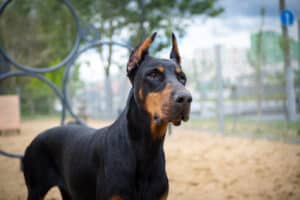 I believe you don’t raise an eyebrow when a Labrador is described as “ball crazy” or catch a Border Collie herding anything that moves—including the kids. I get it: these behaviors are baked into their breed’s DNA.
I believe you don’t raise an eyebrow when a Labrador is described as “ball crazy” or catch a Border Collie herding anything that moves—including the kids. I get it: these behaviors are baked into their breed’s DNA.
Yet, when it comes to high-drive protection dogs, we often jump in without fully grasping the traits that make these animals tick.
To put it plainly, protection dogs are purpose-built. They’re bred to guard, protect, and—when the stakes are high—neutralize threats.
These traits make them extraordinary protectors but also come with a set of challenges that not every owner is equipped to handle.
From their commanding presence to their swift movements, every inch of their build screams capability.
Sure, you want a fearless dog—but too much fearlessness? That’s a recipe for aggression. The ideal protection dog strikes a balance: calm, patient, confident, and just defensive enough to respond when needed.
Confidence and a solid genetic foundation are key here. This is why picking the right bloodline isn’t just important—it’s essential.
A smart dog doesn’t just follow commands; they evaluate situations. The best protection dogs know when to step in and when to stand down.
Drive and consistency are everything. A trainable dog doesn’t just listen—they adapt and perform reliably under pressure.
These dogs are hyper-aware of their surroundings, reacting swiftly and decisively to potential threats.
A protection dog takes their job seriously, guarding their owner and property with vigilance. They’ll issue a warning at the first sign of something off but remain obedient to your commands.
A strong bond with their handler isn’t optional—it’s foundational. A loyal dog stays attuned to your presence, seeks your permission before acting, and is fiercely protective when needed.
Traits to Consider Before Choosing a Protection Dog
Now, here’s the catch: The very traits that make these dogs exceptional protectors can also make them a challenge for the unprepared owner.
Loyalty can become overprotective. Intelligence can lead to stubbornness. Confidence without proper guidance can escalate into dominance.
And let’s not forget size. A dog that weighs 100 pounds or more isn’t just an imposing figure—it’s a living, breathing force. When that force isn’t trained or controlled, it can spell disaster.
Now, a quick talk about…
Training isn’t optional; it’s the cornerstone of what turns a capable dog into a reliable protector. Without consistent, intentional training, even the best-bred protection dogs can become liabilities.
Here’s where training transforms the raw potential of these breeds:
This may seem patently obvious, but it makes a big difference when looking for a protection dog.
So….
You might have come across “What dog breed should I get?” quizzes on the internet. And let’s be honest: many of these suggestions are way off the mark and many people end up choosing breeds that are not ideal for their lifestyles.
This is inconvenient at best, but in the case of most working dogs, training can go a long way. But when it comes to protection dogs, there’s no room for error.
So, here are the best breeds for protection work, proven through decades of real-world experience by military, law enforcement, and professional protection dog trainers:
Overview
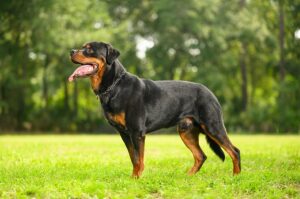
Their impressive physical presence is matched by an equally remarkable character—brave, beautiful, confident, loyal, and intelligent.
Temperament
Despite common misconceptions about aggression, well-trained Rottweilers are notably composed dogs. However, they can display dominance and may show same-sex dog aggression or prey drive toward cats.
They often remain calm and collected in situations that other breeds would find stressful. It takes quite a bit to unsettle them or shake their confidence.
Most Rottweilers are affectionate “gentle giants” with their families, combining fierce protective instincts with a loving, playful disposition.
Appearance
These dogs command attention with their muscular build and distinctive coat. Their straight, coarse, dense black fur features rich mahogany, tan, or rust markings, creating their iconic appearance. While they shed moderately year-round, expect increased shedding during spring and fall.
Exercise and Training Requirements
Rottweilers possess the high energy levels typical of working breeds. They require significant daily exercise—several miles of walking or running—and thrive with mental challenges like agility training.
Their intelligence and work ethic make them exceptional service and protection dogs, but these same qualities demand an owner who can provide:
And while they excel in protection work due to their territorial instincts and loyalty, they need an experienced hand who can channel their strong-minded nature effectively.
Overview
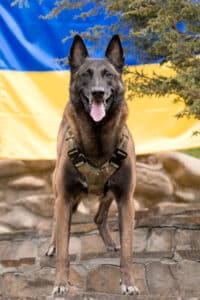
Standing 22 to 26 inches tall at the shoulder and weighing between 50 and 90 pounds, these dogs combine power with grace, typically living 9 to 13 years.
Temperament
Devotion runs deep in the German Shepherd’s veins, and they thrive on companionship.
This is not the breed for someone who is rarely home, lives in a cramped space without a yard, or lacks the time to dedicate to their dog. Without proper engagement, they can develop anxiety or boredom, leading to destructive behaviors.
German Shepherds are gentle family members and fearless guardians. But according to AKC, their breed standard describes them as having “a certain aloofness that does not lend itself to immediate and indiscriminate friendships.”
While this might sound standoffish, it’s a trait that underscores their loyalty and cautious nature, making them discerning protectors.
Their sharp intellect makes them quick learners, but that same intelligence can lead to occasional stubbornness if not guided with patience and consistency.
Appearance
With their athletic build and striking features, German Shepherds are undeniably eye-catching. They possess a dense, double coat that can vary in color, from classic black and tan to sable and all-black variations.
Their erect ears and alert expression exude confidence and intelligence. While they shed year-round, expect heavier shedding during seasonal changes.
German Shepherds embody the high energy levels typical of working breeds. They require ample daily exercise.
A leisurely walk won’t cut it; they need daily physical and mental stimulation to stay balanced and content.
A jog, a vigorous game of fetch, or a hike through varied terrain can do wonders to prevent frustration and boredom.
Engaging in mentally stimulating activities like obedience training or agility exercises is crucial for their overall well-being.
Their legendary intelligence and trainability have made them the go-to choice for military, police, and protection work worldwide. However, these same qualities require an owner committed to providing:
Their intelligence and protective nature make them a great fit for active families with children, provided they are well-trained and socialized.
Overview
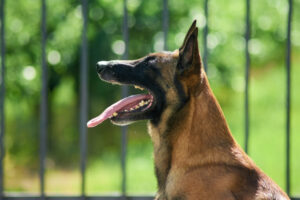
Standing 22 to 26 inches at the shoulder and weighing between 40 to 80 pounds, these medium-sized dogs pack a powerful presence into their sleek, athletic frames.
With a lifespan of 12 to 14 years, they are among the most energetic and enduring breeds in the working-dog category.
Temperament
Belgian Malinois are renowned for their loyalty and intense drive. They form strong bonds with their handlers and thrive on close companionship.
While they’re affectionate and playful with their families, their protective instincts run deep. This breed is naturally suspicious of strangers, making early socialization essential.
Malinois are fearless in the face of threats, and their sharp intelligence often outpaces their human counterparts.
However, this intellect comes with a caveat: an untrained or under-stimulated Malinois can quickly become frustrated, leading to undesirable behaviors.
Appearance
With a sleek, muscular build and a short, weather-resistant coat, Belgian Malinois are built for speed and stamina.
Their coats typically range in shades of fawn, mahogany, or red, with a black mask and ears adding to their striking appearance. Their expressive, almond-shaped eyes reflect their intensity and intelligence.
Exercise and Training Requirements
The Belgian Malinois is not for the faint of heart—or energy. These dogs require rigorous daily exercise and mental stimulation to thrive.
Think long runs, agility training, and problem-solving games that challenge their minds. A bored Malinois is a recipe for destruction, as their high drive and energy can quickly lead to mischief.
If you’re willing to meet their demanding needs, Malinois excel in protection work, search-and-rescue missions, and competitive dog sports.
Their work ethic demands an owner who can provide:
Overview
Standing 24 to 27 inches tall and weighing 100 to 130 pounds, this gentle giant was originally bred to guard estates and deter poachers. With a lifespan of 7 to 10 years, Bullmastiffs are a formidable yet loving breed.
Temperament
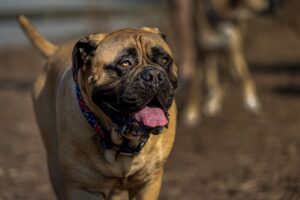
However, don’t mistake their calm nature for a lack of vigilance. These dogs are naturally protective and can act decisively when they sense a threat.
They require consistent training and socialization to ensure their protective instincts are channeled appropriately.
When raised with children, Bullmastiffs are typically affectionate and gentle. However, due to their large size, supervision around small children is essential to prevent accidental knocks or reactions to mistreatment.
For families with younger kids, it’s worth considering waiting until the children are older before introducing a Bullmastiff to the household.
Appearance
Their massive, muscular build is complemented by a short, sleek coat that comes in striking shades of fawn, brindle, or red. Their broad heads, wrinkled brows, and expressive dark eyes project both power and gentleness, making them as visually imposing as they are endearing.
Exercise and Training Requirements
Bullmastiffs are less demanding in terms of exercise compared to other protection breeds like German Shepherds or Belgian Malinois.
While they enjoy daily walks and moderate physical activity, their primary focus is companionship and protection rather than high-intensity work.
Key Considerations for Exercise:
If you’re someone who values a laid-back, low-maintenance companion, a Belgian Malinois is going to run circles around your patience (and probably your furniture).
On the flip side, if your idea of fun involves scaling mountains and hitting the trails, a Bullmastiff’s relaxed vibe might feel more like dragging dead weight.
I get it—you may have your heart set on certain breeds or drawn to their unique characteristics. But here’s my advice: seek professional guidance.
And where do you start? Vanguard Protection Dogs.
We don’t just match you with a protection dog; we pair you with the right dog for your lifestyle and security needs. Because let’s face it—making the wrong choice isn’t just inconvenient , it’s unfair to you and the dog.
Vanguard understands that each breed comes with its strengths, quirks, and energy levels.
That’s why we take the time to evaluate your activity level, family dynamics, and security goals, ensuring that you find the perfect match for your home.
Still interested?
Schedule a Free Consultation Now and let’s get started on securing your peace of mind!